
Grab-and-go is becoming more than common – it’s becoming routine.
An annual growth rate of 10.4 percent between 2006 and 2014 launches the supermarket fresh prepared foods segment into the food industry’s group of highest performing subdivisions, according to a recent Technomic study cited by an FMI about made-to-order food’s prevalence in grocery stores.
But, it’s not just supermarkets. Healthcare, education, industry and other segments are finding the need to implement grab-and-go equipment into their floor plans in order to take advantage of an unprecedented rise in impulse-driven food sales.
Quick, high-intensity customer movement, according to findings published in a recent Foodservice Equipment & Supplies trend report, is reliant on design.
In healthcare, where noncommercial foodservice operators expect half of their customers to grab meals to go, customer foot traffic is just one of the many considerations that dictate retail foodservice design layouts, the report states.
“While time-crunched, lunch-rush consumers are a fact of life on the commercial side, time pressure is even more intensified in healthcare operations,” the report articulates. “In such an environment, where speed of movement through the line is essential, proper equipment placement becomes an even bigger consideration.”
Satisfying these customers’ short time windows is easier when equipment placement makes sense. Manage traffic flow with ease thanks to these suggestions straight from the report:
- Place beverage coolers in places where they won’t disrupt traffic flow.That means avoiding busy spots where customers are already waiting in line for something else.
- Make restocking easy.Stock your floor with coolers that can be refilled from the back.
- Stay prepared.Plan to keep backup refrigeration close to upright refrigerated air screen coolers and keep items pre-chilled to make sure food that goes into upright, open air refrigerator models stays fresh, safe and at the right temperature.
- Grab customers’ appeal with eye-catching design.Try implementing shaped or curved merchandising units to mix up classic C-store design.
Foodservice directors and operators can thank increased overall customer perception for the recent growth in the grab-and-go culinary takeover, according to a separate Foodservice Equipment & Supplies article. Generally, customers tend to pick up grab-and-go foods for purchase as an impulse. That impulse, unsurprisingly, extends into the restaurant sector as well, as evidenced by findings from a Technomic survey that said 69 percent of consumers turn to grab-and-go foods for “added convenience,” with 45 percent of restaurant customers seeking the same level of accessibility.
But if operators want to encourage impulse-driven sales, efficient equipment and supplies – just like high-volume customer movement – remains king.
“The top triggers that prompt consumers to purchase grab-and-go items include more options, less time to cook, higher quality offerings, less time to dine in at restaurants, and improvement in grab-and-go packaging. In other words, grab-and-go items are becoming part of consumers’ routines,” the article suggests. “As the grab-and-go food segment keeps growing, the need for attractive, efficient refrigerated display cases continues to rise.”
Keep premade food fresh and appealing with refrigerated displays that enable attractive presentation and reduced energy consumption.
Operators who make the switch to open-front, easy-to-access grab-and-go display units instead of closed-door displays boost their bottom lines – some by as much as a 50 percent sales increase, according to the article from Foodservice Equipment & Supplies.
Implement eye-catching, energy efficient equipment with these suggestions:
- Replace the energy guzzlers.Implement rifled copper tubing into refrigerator equipment and replace electric pans with hot gas condensate pans to lower energy consumption.
- Make decisions based on the unit’s overall life cost.Look beyond an equipment’s initial purchase price to consider the long-term returns an energy-efficient unit would mean for your bottom line in terms of energy saved in annual operating costs.
- Keep it clean.Grab-and-go display models are the most energy efficient when operators execute proper clearance around the unit; that means allowing for breathing room to prevent the condenser from overworking itself in tight spaces.
- Size matters.Grab-and-go display units maintain higher levels of energy efficiency when the model has the proper ventilation space, including being surrounded by cool air.
- Invest in a night cover.Keep cold air inside and reduce overall energy loss by covering the grab-and-go unit with a night cover.
Impulse-driven sales, just like customer movement and floor plan efficiency, come from decision-making principles invisible to the naked eye. Cashing in on impulse spending, according to a Global Packaging market research study from The Association for Packaging and Processing Technologies, includes finding ways to implement environmentally-friendly messages and customizable elements into foodservice packaging.
Capitalize on more impulse-purchases from consumers by following any, or all, of the three trends that the study listed as having a global impact on the packaging market:
- “Greater consumer awareness of health and wellness.”Let consumers know what products are produced sustainably in order to impact your bottom line.
- “Stronger influence of recycling and environmental issues.”The study names a package’s “recyclability and reusability of packaging” as a major consumer purchasing power. Look for ways to include PET and glass bottles for beverages and find ways to implement conservation tactics into packaging.
- “Increasing disposable income and purchasing power.”The study points to eye-catching, non-traditional packaging types as a way to attract consumers.
Source: The NAFEM Show
